Get ready to learn some fun and interesting facts about baby peacocks. These adorable little birds will grow into some of the most impressive avian specimens on the planet. With their long tails and impressive wingspans, they rank among the largest flying birds. Appreciated by royalty since ancient times, peacocks now live in flocks all over the world and have been bred in many colors and variations. Let’s take a look at some cute pictures of baby peacocks and learn more about them now.
Baby Peacocks Hatch Ready to Go

As precocial birds, baby peacocks hatch with feathers and ready to move and forage on their own.
©Rob Croukamp/iStock via Getty Images
When baby peacocks hatch, they already have feathers, and they emerge from the shell ready to move around on their own and forage independently. This type of animal, born or hatched nearly ready to follow its parent, is known as precocial. Other types of animals, called altricial, hatch or give birth to offspring that need to develop further before they can move about on their own.
Baby Peacocks Are Called Peachicks

Peacocks rarely spend time with peachicks. Peahens do the work of raising their offspring on their own.
©Christine C Brooks/Shutterstock.com
Although people might simply call peacocks of all sizes peacocks, the birds collectively are known as peafowl. Peafowl includes male birds, known as peacocks, and female birds, known as peahens. Baby peacocks are known as peachicks. Peahens do most of the raising of peachicks on their own. Peacocks spend little time with their offspring.
Peachicks Face Many Threats to Their Survival
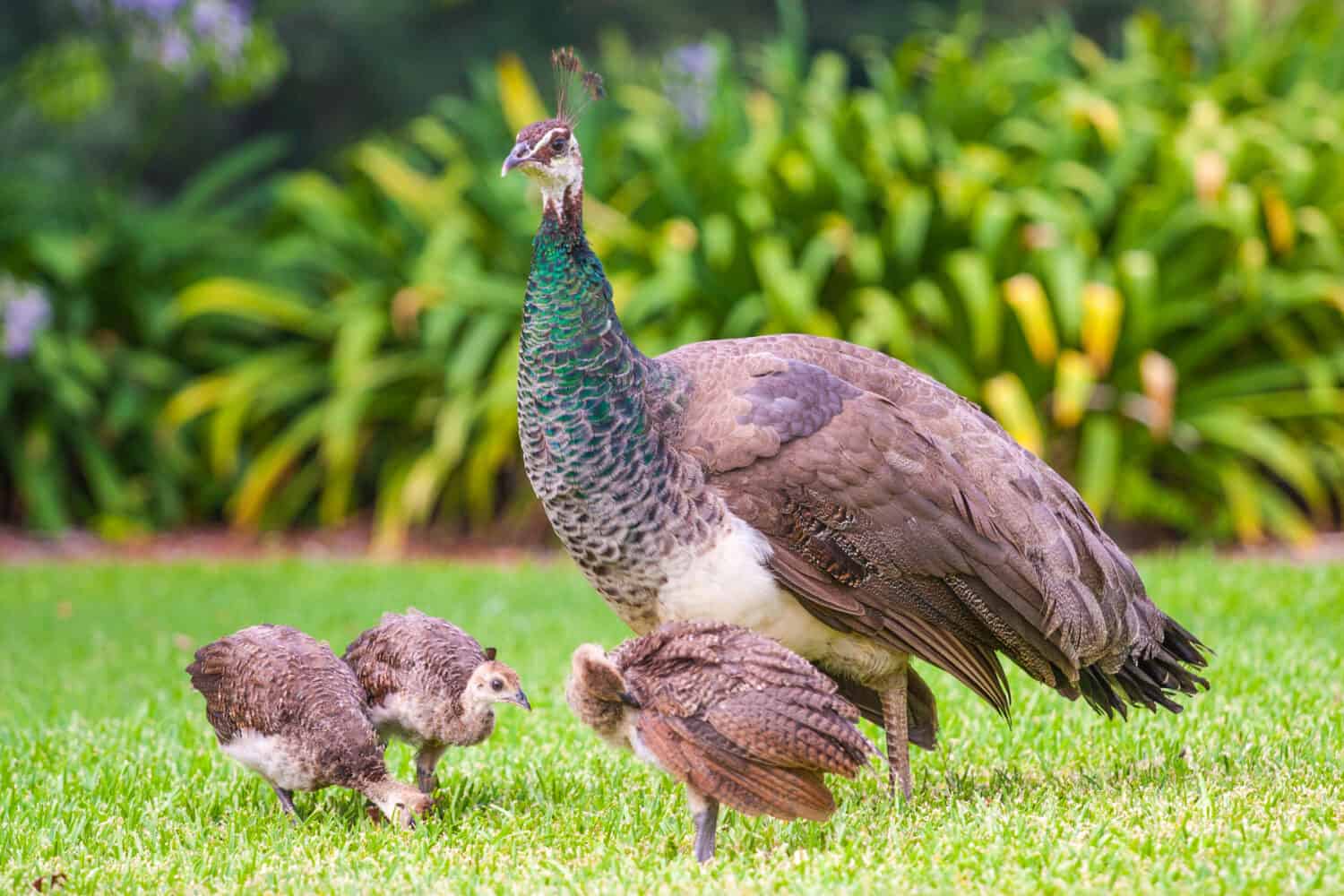
Only about two out of every six peachicks survive to maturity.
©PaxPhongTrinh/Shutterstock.com
Peafowl produce clutches of about three to eight eggs. However, some estimates indicate that only about two out of every six peachicks survive to maturity. Some common predators of peacocks include wild cats, such as leopards and tigers, wild dogs, foxes, mongooses, raccoons, and more. Snakes sometimes go after peacock eggs, but that is risky business, as peacocks are known to kill and eat even venomous snakes.
Feathers of Baby Peacocks Do Not Match Their Adult Plumage
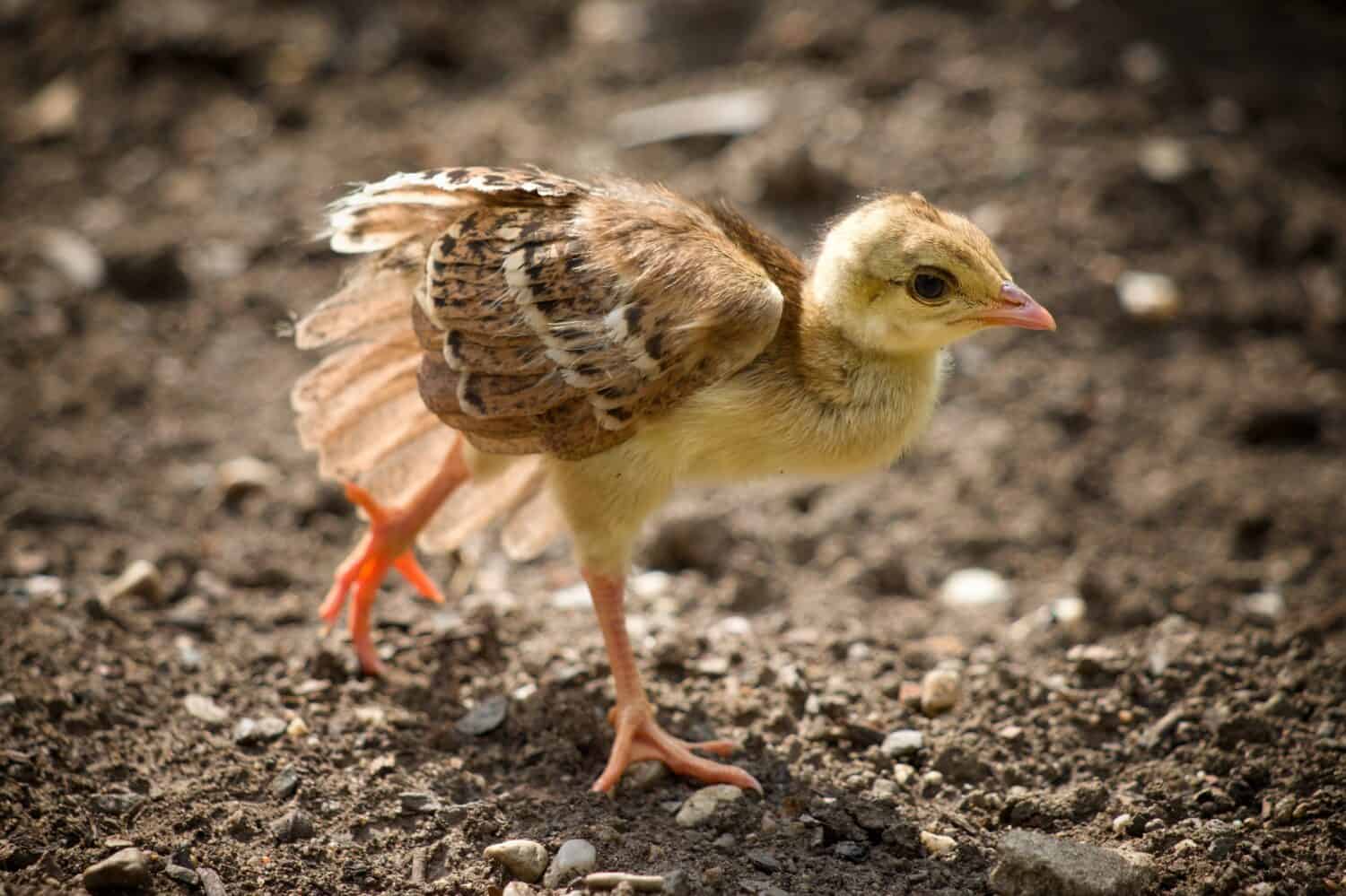
Baby peachicks have plain feathers that help them blend with their environment.
©Tomasus123/Shutterstock.com
When peachicks hatch, they have feathers that are tan and gold, with a pattern that helps them to easily blend into their environment. While adult peafowl prove easy to spot, especially the ornately colored male peacocks, tiny peachicks can practically disappear in the grass. This camouflage helps the babies to survive as they follow after their mothers and forage from the very beginning of their life.
Peachicks Develop Darker Plumage as They Mature
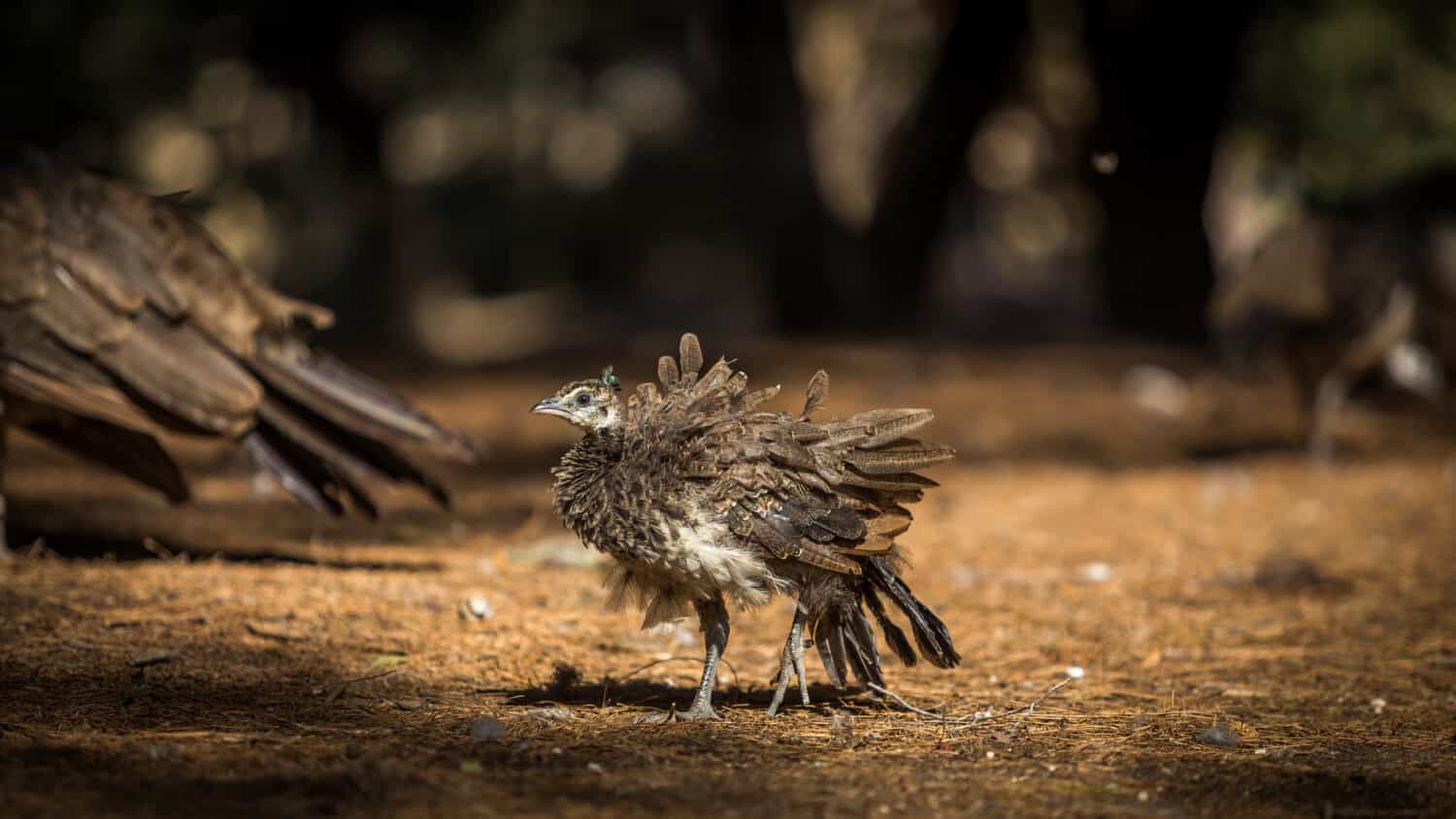
Peachicks develop their crests by the time they reach about four months of age.
©Martin Minarik/Shutterstock.com
As peachicks begin to mature, they develop darker plumage. They grow in crest feathers by about one month of age, and their other plumage begins to more closely resemble the feathers they will have as adults. It will take the males some time, at least two years, to grow into their colorful plumage. It will take even longer, up to six years, for them to grow their full and magnificent tail feathers, which can reach lengths of up to five feet.
Peacocks Come in Many Variations
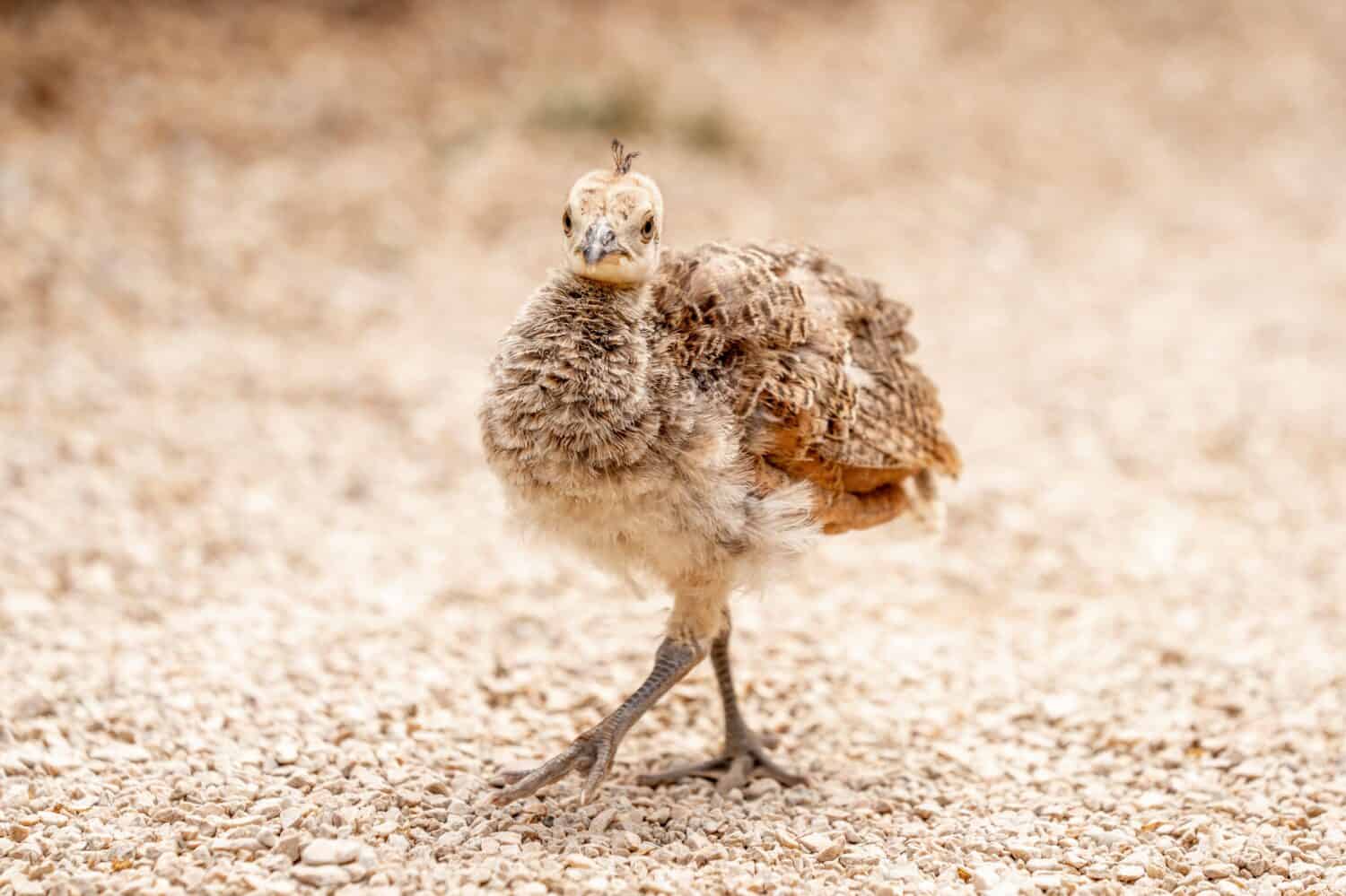
Three different species of peacocks exist, but they come in a large number of color variations.
©PIC by Femke/Shutterstock.com
Most people are familiar with the Indian peacock, Pavo cristatus, which has brilliant blue feathers on its body and an ornate tail resplendent with eyespots. This species, long domesticated and bred all over the world, now exists in different color variations and patterns, including white, violet, peach, and many more. The less common, green Javanese peacock, Pavo muticus, originated in southeast Asia. Its body, typically covered in green feathers, has a golden tail with eyespots. The Congo peacock, Afropavo congensis, a related bird from Africa, has much less ornate plumage than the other species and is comparatively rare. Baby peacocks of all three species have plumage that differs significantly from what they will have at maturity, but experienced breeders can tell from an early age what color variation the babies will present.
Baby Peacocks Practice Displays Early
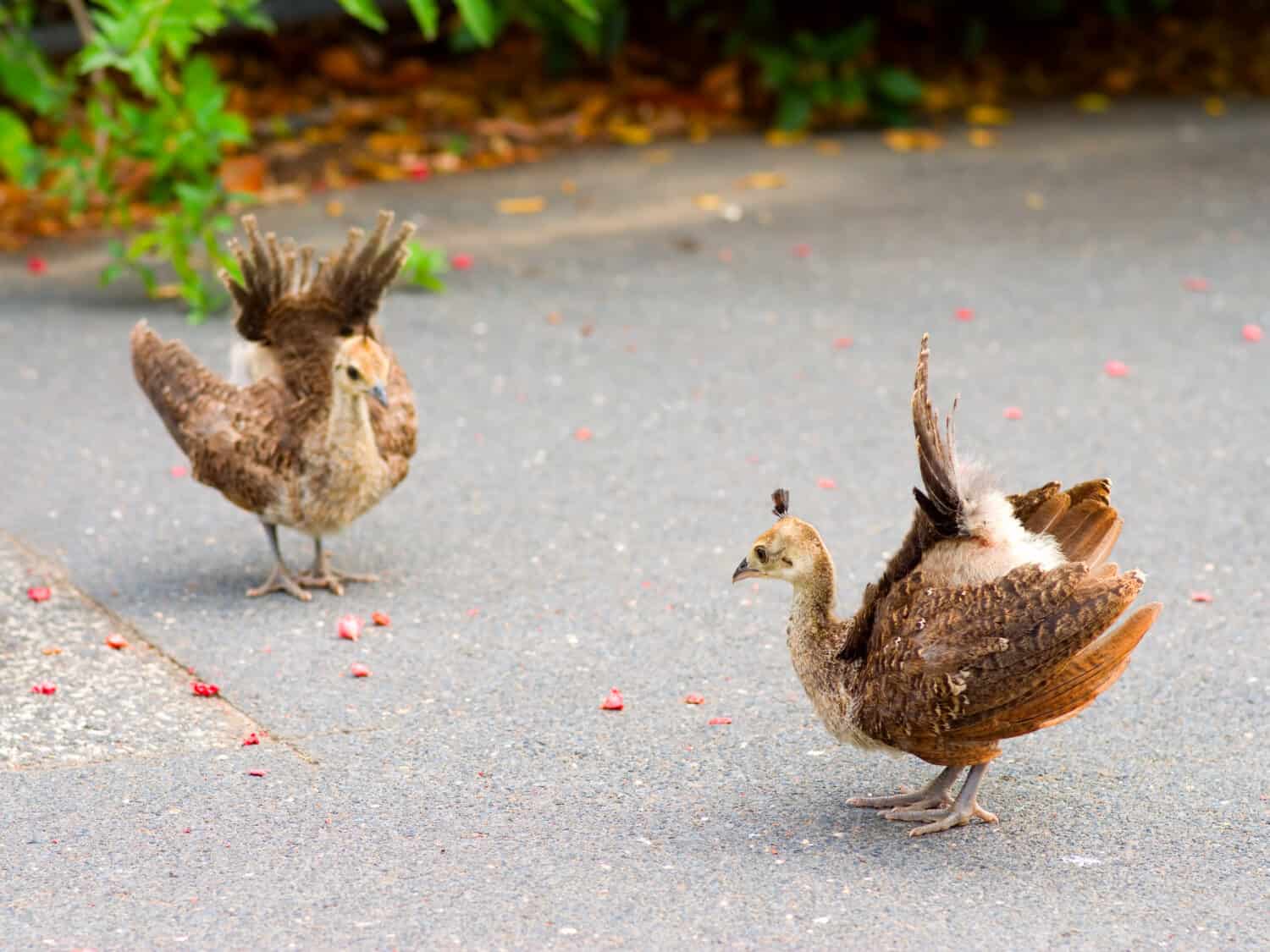
Even as young birds, baby peacocks begin posturing with wing and tail displays.
©Ashley Whitworth/Shutterstock.com
Young peacocks begin practicing their displays long before they grow impressive plumage. They stretch their wings out and down, and they flex their tails to spread and display their feathers the best they can. These displays will prove important eventually for enticing mates, deterring predators, and challenging one another. The more they practice, the better they’ll get.
Peachicks Stay with Their Mothers for up to Six Months

Peahens watch over their young for up to six months in the wild.
©PixSaJu/Shutterstock.com
In the wild, peahens act as very attentive and protective mothers. Because they nest on the ground, their offspring are extremely vulnerable at first. The peachicks cannot follow their mothers up into bushes or trees to roost until they reach at least two weeks of age. Even then, they must come back down to forage in the morning and near dusk. Peachicks stay close to their mothers, especially for the first several weeks. They do not fully leave their mothers until they reach about six months of age in the wild. In captivity, they become independent much earlier.
Conclusion
Baby peacocks may not look much like adults, but they have a cute and feisty quality that makes them irresistible. Do they know how majestic they will one day appear? Do they have any idea how people have revered them for centuries in cultures around the world? No, they probably do not have any idea about all that. They just want to learn to shake their tail feathers, forage successfully, and grow up to be like their parents. That is not a bad goal.
The photo featured at the top of this post is © Rob Croukamp/iStock via Getty Images
Thank you for reading! Have some feedback for us? Contact the AZ Animals editorial team.






